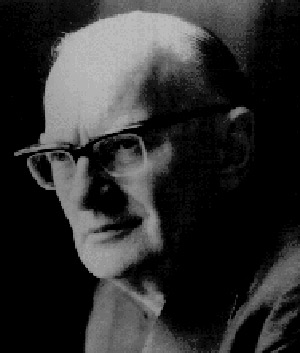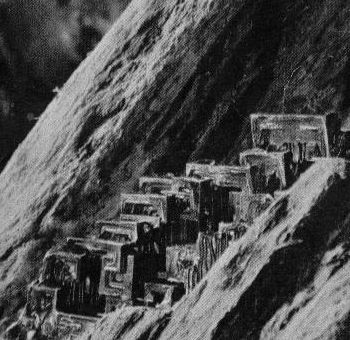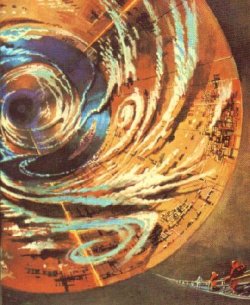Clarke, Arthur C(harles) (1917–2008)

Figure 1. Arthur C. Clarke.

Figure 2. From the cover of a paperback edition of The City and the Star.
Arthur C. Clarke was a British author (resident in Sri Lanka since 1956) of science fiction and popular science who worked on the development of radar during World War II, originated the concept of communications satellites in the October 1945 issue of Wireless World1 (see Clarke Belt), and earned a first-class degree in physics and mathematics from Kings College, London (1948). His nonfiction books of the early 1950s, including The Exploration of Space (1951),2 brought him fame as an enthusiastic advocate of space travel, although he had begun writing science fiction two decades earlier, influenced most significantly by Olaf Stapledon's Last and First Men.
Informed by his science and engineering background and suffused with his liberal optimism about mankind's destiny among the stars, Clarke's writings combine meticulous technical authenticity with an almost mystical vision of the future. The notion the next stage human evolution will be inextricably bound up with extraterrestrial contact is recurrent throughout his work. In Childhood's End3 (1953), The City and the Stars4 (1956), and 2001: A Space Odyssey5 (1977) and its sequels, Clarke employs highly advanced aliens as agents of human transformation, while in Rendezvous With Rama6 (1973) and its sequels, he explores the idea of first contact with an outside intelligence in the form of a robotic alien ship which temporarily enters orbit around the Sun (see Bracewell probe).
Several prognostications made by Clarke in his novels have subsequently been borne out in fact, including the possibility of life on Europa and the existence of a moon around Pluto. Among his scientific contemporaries who used fiction to speculate about the nature of alien life and intelligence, and the consequences of human-alien contact were Hal Clement in the United States and Fred Hoyle in Britain.
Childhood's End
In Clarke's novel Childhood's End (1953) benevolent aliens, with the appearance of devils, arrive on Earth and establish peace and a world government. Despite their enormously superior knowledge and technology, however, these "Overlords" are far less advanced than the "Overmind" – a communal consciousness that is poised to absorb the youngest members of the human race (see noncorporeal life). The Overlords themselves, incapable of making this dramatic evolutionary jump, serve merely as midwives for other species that are in the throes of undergoing the transition from individual corporeal to collective noncorporeal form.
The City and the Stars
The City and the Stars (1956) is an expanded version of Clarke's first science fiction novel (Figure 2). Heavily influenced by Olaf Stapledon's cosmic visions, it tells of an inhabitant of the utopian but totally insular Earth city of Diaspar, who escapes to travel the Galaxy. He thereby learns of man's past encounters with galactic civilizations leading to a vast experiment – the creation of a non-corporeal intelligence. Clarke was to echo this theme of human destiny lying among the stars in some of his other well-known works, including Childhood's End and 2001: A Space Odyssey.
Rendezvous with Rama
 |
In Rendezvous with Rama (1973) a vast and apparently derelict alien spacecraft arrives in the solar system. A ship is sent from Earth to investigate before the enigmatic craft, called Rama, disappears. The astronauts given the task of exploring the hollow cylindrical interloper are able to decipher some, but by no means all, of the extraterrestrial vehicle's puzzles. From the ubiquitous trilateral symmetry of its structures to its cylindrical sea and machine-island, Rama's secrets are clues to the nature of the advanced civilization that built it. But who, and where, are the Ramans, and what do they want with humans? Perhaps the answer lies with the busily working biots, or the sealed-off buildings, or the inaccessible "southern" half of the enormous cylinder.
Clarke collaborated with Gentry Lee in writing several Rama sequels, beginning with Rama II.
References
1. Clarke, Arthur C. "The Future of World Communications." Wireless
World, October 1945.
2. Clarke, Arthur C. The Exploration of Space. New York: Harper,
1952.
3. Clarke, Arthur C. Childhood's End, New York: Harcourt, Brace
and World (1963) (First published in 1953).
4. Clarke, Arthur C. The City and the Stars, New York: Harcourt,
Brace (1956).
5. Clarke, Arthur C. 2001: A Space Odyssey, New York: New American
Library (1968).
6. Clarke, Arthur C. Rendezvous with Rama, New York: Harcourt,
Brace, Jovanovich (1973).


